
- Roller Hockey Tutorial
- Roller Hockey - Home
- Roller Hockey - Overview
- Roller Hockey - Playing Environment
- Roller Hockey - Equipment
- Roller Hockey - How to Play?
- Roller Hockey - Shots and Tactics
- Roller Hockey - Penalties
- Roller Hockey - Championships
- Roller Hockey Useful Resources
- Roller Hockey - Quick Guide
- Roller Hockey - Useful Resources
- Roller Hockey - Discussion
Roller Hockey - Quick Guide
Roller Hockey - Overview
Roller hockey is a fast paced hockey sport mostly derived from ice hockey and is played on harder surfaces. It is played between two teams as an indoor as well as an outdoor game. There are two different categories in this game which are Quad Hockey and Inline Hockey.
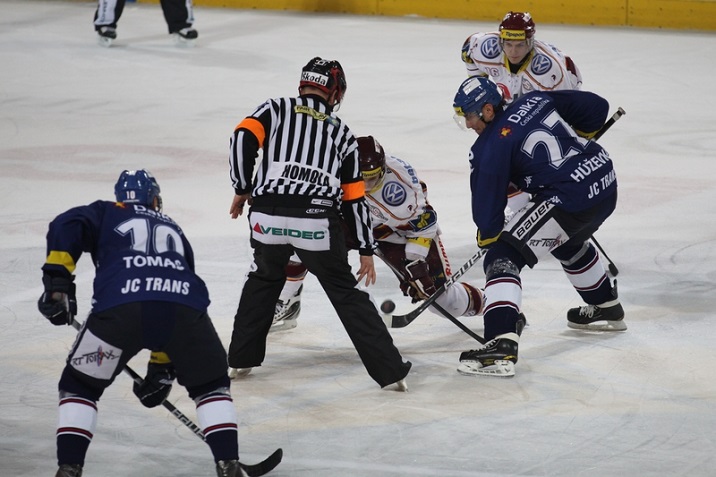
In this game, players need to drive the ball to the opponent’s goal post using their hockey stick. The goalies of the respective teams prevent the opponent players to hit a goal by protecting the goal post. After the fixed duration, the team that has scored more goals wins the game.
History of Roller Hockey
The first set of roller hockey was invented by John Joseph Merlin in 1760 at London. People were so addicted to Ice Hockey that they wanted to play it even when the ponds were melted after the winter. So they laced up roller skates and started playing on dry lands. The first hardball roller hockey game or quad hockey was played in England in 1878.
The first world championship of roller hockey was organized in 1936 in Stuttgart, Germany whereas the first sanctioning body of roller hockey, The International Roller Sports Federation (IRSF), was founded in 1924. Even if quad hockey was a substitute to ice hockey, it was very much slower than ice hockey which was a major drawback for roller hockey.
In 1940, Roller Skating Rink Operators Association (RSROA) published a revised set of rules for roller hockey in order to again revive the interest of people which was then named as Puck Roller Hockey. In 1960s, the Olsen brothers Scott and Brennan Olsen redefined the inline skating shoes. In 2005, it was introduced to World Games.
Participating Countries
Even though, having a lot of similarity with ice hockey, roller hockey still enjoys popularity all over the world. The not-so-complex rules as well as the high level excitement throughout the game helps it gaining rapid popularity. In some countries like Spain, Portugal and South American countries, it is hugely popular besides soccer and basketball.
Some of the countries where roller hockey is quite popular include Portugal, Chile, Italy, Argentina, South Africa, USA, England, Germany, Switzerland, Brazil, France, and Egypt.
Roller Hockey - Playing Environment
The game is usually played in a rectangular shaped playground which is usually flat, non-slippery, and is made of wood, cement or sports tile surface. Usually the arena has three standard sizes, which can be a minimum of 34x17 meters or an average size of 40x20 meters or a maximum size of 44x22 meters. The arena has round corners with a one meter wall surrounding it.
The markings made on the rink are simple. One line is drawn at the middle of the ring dividing the ring in two halves. An anti-play line is drawn 22 meters away from the end wall. This area is a 9 X 5.40 m rectangle and is placed 2.7 metres to 3.3 metres away from the end tables. A half circle with 1.5 m radius is drawn in the rectangle and is considered as the goalie protection area.
At the end of both sides, two goal posts are there whose size differs between game types. In case of quad hockey, the goal posts are 105 cm high and 170 cm wide whereas in case of inline hockey, the cages are very much similar to ice hockey cages. A wall of around 6 feet surrounds the playing area.
Roller Hockey - Equipment
Even though roller hockey is a fast paced fun sport, physical contact between the players is quite common throughout the game which may result in injuries. In order to avoid injuries, players use different protective equipment. The equipment used by players differ from goalie equipment.
Player Equipment
The players use the following equipment while playing roller skating −
Clothing
In case of quad hockey, the clothes used by the roller hockey players are very much similar to that of football players. All players use socks up to the knee, shorts and sports shirts or jersey.
The jerseys usually cover the shoulders as well as elbow parts. The pants used can be either shorts or ice hockey pants.
Hockey sticks
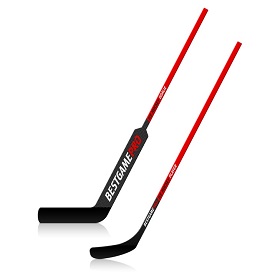
The sticks used in this game are different for players and goalies. Usually made of either wood or composite materials, the stick dimensions vary based on the size of the players.
The stick length has to stay between 90 cm to 115 cm. Similarly, the stick shouldn’t be wider than 5 cm or weigh over 500g. The present sticks are mostly made of graphite.
Ball
Only in case of quad hockey, a ball is used; whereas in case of inline hockey, a puck is used. The ball has a weight of around 155 gram and it is 23 cm in circumference. The ball is usually made of vulcanized rubber.
Puck
The pucks are used in roller inline hockey and are also made of vulcanized rubber. All pucks have a diameter of 3 inch with 1 inch thickness and a weight of 170 gram.
Skates
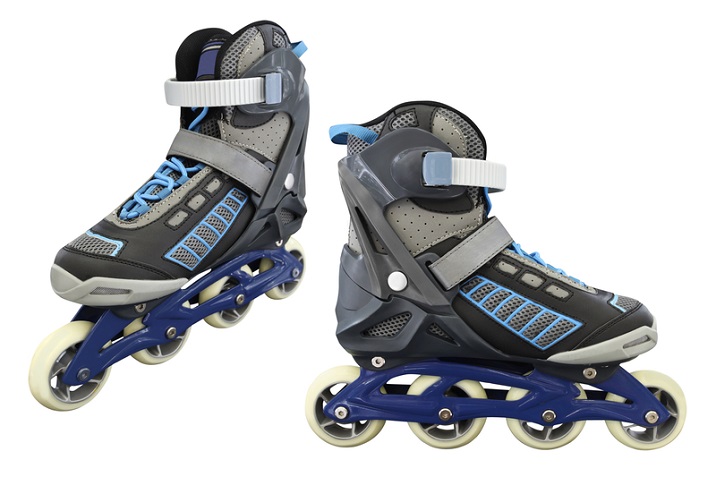
There are two types of skates available in roller hockey based on type of games and rules. In quad hockey, roller skates are used while in inline hockey, inline skates are used. Roller skates come with four wheels that can be tied around foot which enables the player to roll along with the wheels.
As compared to ice hockey skates, these skates turned out to be real slow affecting the pace of the game. In case of inline hockey, the skates have a set of wheels arranged in a single row which provides the riders not just better control and skill sets but also boost the pace of the game.
Protective Guards
As it is a contact sport, suffering injuries because of physical contacts during the play cannot be avoided. In order to avoid accidents and injuries, players use different protective guards for their safety. Some of the protective guards, which are used in roller hockey are explained below.
Helmet
A helmet is used as a basic protective equipment to prevent head injuries during contact. These helmets are mostly made of flexible thermoplastic with a strap to tighten it. The front part of the face is protected by a face cage attached to the helmet.

Neck guard
The neck guards consist of a series of nylon plates for puncture resistance with padding for better comfort. In case of goalies, the neck guard is in a curve shape.
Shoulder pads
These shoulder pads are typically a vest with front back panels and straps for better closure. The hard shelled arm cups are there for arm protection from physical contacts or collisions during the game. These pads provide protection to chest, arms, ribs, spine, and shoulders.
Other body guards
Other protective body pads include elbow pads which have a reinforced elbow cup for elbow as well as forearm protection and shin guards which are made of hard plastic shells and provide protection to knee joints and frontal bones. Jock straps are used for providing protection to genital parts whereas for hand protection, gloves are used.
Goalie Equipment
The equipment used by the players differ from the equipment used by the goalies. As a matter of fact, goalies use a lot of protective equipment in order to prevent accidents that are likely to happen frequently.
Gloves
In case of gloves, there is a huge difference between inline goalie and quad goalie. In case of inline hockey, goalie uses a catcher glove in order to catch the ball that is pointed at the goal whereas in case of quad hockey; a flat batting glove is used by the goalie to rebound the ball instead of catching while blocking it.
Chest arm protector
Similar to the players, goalies also use chest and arm protectors in order to protect their chest, arm as well as collarbone areas. Mostly these products are made of hard plastic in order to provide better protection.
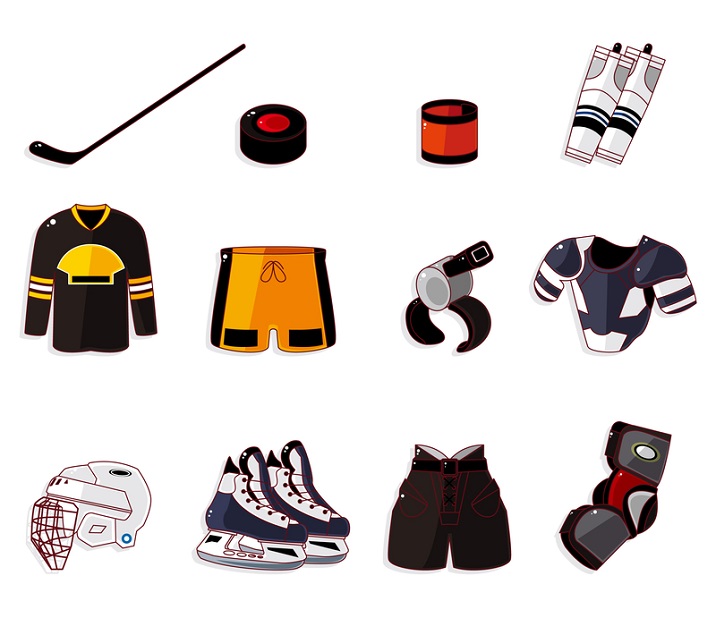
Leg Pad
The leg pads used by goalies are specially made and are meant for leg as well as knee protection. These pads are mostly made of synthetic leather and foam. These pad lengths usually are of 38 inches whereas width is of 11 inches.
Helmets
The helmets used by the goalies are specially made and can withstand severe high speed blows. A neck guard hangs below the helmet for preventing neck injuries. The helmet also has net at front to protect the face from any injury.
Goalie stick
In case of goalies, the stick used is very different as compared to the player’s stick. The goalie’s stick has a wider shaft and is mostly made of wood with fibre glass panels for better impact results and longer durability. These sticks are mostly used for blocking the ball from entering the goal.
Roller Hockey - How to Play?
Even though the games are played in different fields, based on the type of the game, mostly the rules of both types are very much similar. During the game, each team consists of five players including the goalkeeper. During the game, players try to hit the ball or puck into the opponent’s goal net.
Allocating Positions to Players
Among the four players of a team, two are taken as forwards where as other two play as defenders. While the forward position consists of a center and a winger, the defenders usually stay together in the left and right positions. The goalkeeper prevents the ball from hitting the net.
The forwards are mostly responsible for shooting goals. They are responsible for the offense and attack on the opponent’s goal post. Usually forwards should skate at higher speed while making more accurate shots towards the opponent’s goalpost.
The defenders’ main responsibility is to oppose the forwards of the opponent team from hitting the ball/puck into goalpost. They usually take long and hard passes in order to prevent the opponent to take the control.
The goal keepers are the last line of defense after the forwards and defenders. They stand directly in front of the goalpost and try to prevent the opponent from hitting the ball in to the post. Based on game type, goalies use different glove pads to stop the ball/puck.
Controlling the Ball
In quad hockey, they use a deflecting flat mitt and in inline hockey, they use a catching glove to catch the ball/puck. The players control the ball or puck using the hockey stick which has a curved blade at one end. Players can also redirect the puck or ball with any part of their body but there are certain restrictions to it.
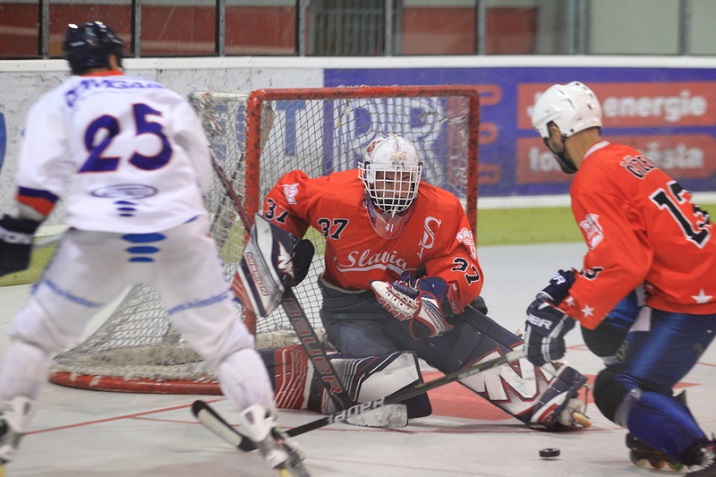
layers can neither hold the ball or puck nor can they pass it using their hands unless and until they are in defensive zone. Players are also prohibited from intentionally hitting the ball or pucks using their foot whereas unintentional hits are permitted. Similarly, players can’t hit the puck or ball using their hand into the goal post. The substitution of all players at once is called as a Line Change.
Duration of a Match
The game usually consists of two halves and their duration depends on the level of the play. In high level leagues, first half is of 30 minutes whereas lower level leagues have short duration of 12 minutes. If the game ends in a tie, then either extra time is given or shootout is played.
During shorthanded or line play, teams usually substitute alternate players to the forward line or defense pairing. Substituting the players is allowed at any point of time during the match, which is also called changing-on-the-fly. However, during the stoppage, the home team is given a final chance for substitution.
The board walls surrounding the ground are used to keep the ball/puck in the match and can be used as a tool to hit the ball. The players are prevented from disrupting the opponents forcefully from making a progress, which is also known as Body check. The referees and outsiders never create stoppage to the play in case the ball/puck collides with them.
Usually the play is not interrupted for long time. Once interrupted, the match again resumes with a face off. In a face off, two opponent players face each other and then try to get the control over the ball/puck once the official drops the puck on the floor. The face-off happens in the proper marking area.
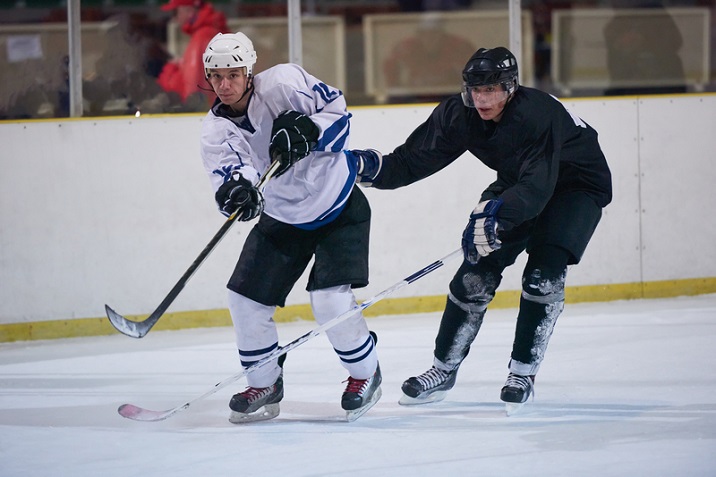
Inline Hockey
In case of inline hockey, the movement of the puck is restricted. If the puck goes out of the rink while crossing the walls and in to the player’s bench or outside net, it is called out of play. In case of an out of play, the puck is considered dead and the match is stopped by the officials at that moment. Each team can use maximum number of 14 players and two goalkeepers as substitutes.
Blind Hockey
Blind hockey is played between players who are either totally blind or visually impaired. Sighted players are also allowed to play in this game as all players have to wear opaque goggles during the game. The blind hockey surface is smaller than the general rink and is around 85' by 60' size while the number of players as well as goalie remains the same.
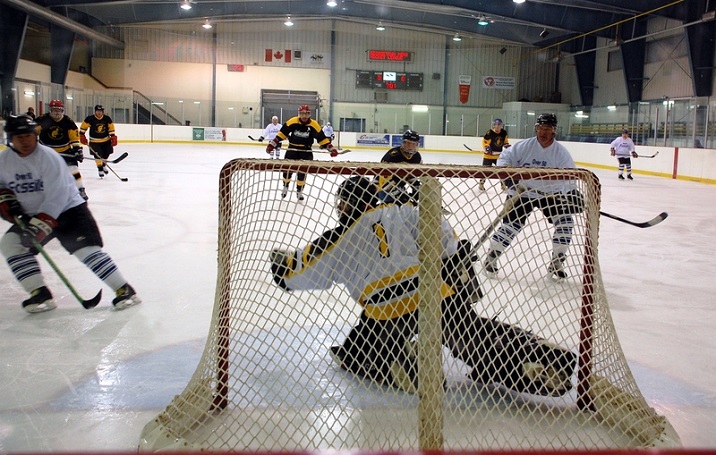
The puck used in this type of game is bigger in size whereas both the puck and the goal posts have a sound device enabling the players to hear the puck and proceed towards the goal post. The players communicate between themselves about the action or team work or tactics throughout the game. A sighted referee directs the game throughout the whole duration.
Roller Hockey - Shots and Tactics
Roller inline hockey is not just all about physical ability to skate through and hit the ball. In order to pass the ball through the opponent’s goalpost, players use various tactics throughout the game to shoot a goal. Some of these shots are as follows.
Shovel shot − It is considered as the most basic and the easiest shot where the players usually push the puck in a shovelling motion in desired direction or flick the puck in different directions. This shot is mostly played, when the puck is loose or the goalie is out of position.
Wrist shot − In this case, the player first positions the puck between the middle of the blade of the stick. Then he places the wrist at one end of the stick and thrusts the puck quickly in order to spin it to hit the goalpost more accurately.
Slap-shot − It is known as the hardest and the trickiest roller hockey shot where the player has to draw his stick high above his shoulder in backward direction and then hit the floor just behind the puck which causes the puck move with extra speed towards the goalpost. The positioning and height of the flow at the beginning determine the trajectory of the puck.
Snapshot − Snap shot is a combination of wrist shot and slap-shot. Here the player starts by drawing the stick high above his shoulder in backward direction and then just before hitting the puck, he rolls his back wrist similar to wrist shot causing the puck move with greater speed and more accuracy.
Other shots − A deflection is a redirected shot where players turn other players pass into a goal. Breaking out is a shot where players rapidly pass the puck to the team mate who is farthest down the floor.
Roller Hockey - Penalties
In case of roller hockey, a penalty is defined as the punishment for the infringement of rules. Usually penalties are enforced by detaining the offending player in a penalty box for a specific period during which, he won’t be able to play in the game. Penalties are enforced by referees and in some cases by linesmen.
Once a player is in the penalty box, the offending team can’t substitute the penalized player during that duration and team is shorthanded as compared to their opponent team whereas the opponent team is said to be on power play having one more player than the shorthanded team. Once the penalty duration expires, the penalized player is again allowed to play.
When there is no player between the attacker and the goalpost except goalie, it is known as breakaway. In this case if the attacker is illegally obstructed, then the attacking team gets the penalty shot where only the goalie of the defending team is there to prevent the goal.
Based on the severity of the infringement of the player, different types of penalties are there which are as follows.
Minor Penalty
When the players act in a dangerous and unfair way during the game, this kind of penalty is imposed. The penalized player has to go to the penalty box for 2 minutes in case of a minor penalty. Minor penalties are enforced when
The opponent players is intentionally hit using shoulder or hip to knock them off the puck.
The opponent player is knocked to the ground using either stick or any part of leg.
The body of the opponent player is contacted above the shoulder with the stick.
The stick is swung against the opponent player’s stick and causing it to break.
The movement of the opponent player is interrupted by grabbing either their equipment or their body.
In case of deliberately delaying the game, elbowing, cross checking also, a player is subjected to a minor penalty.
If the player tries to get the attention of the referee while exaggerating the action of the opposition player in order to draw a penalty, he gets enforced with a minor penalty. Sometimes players are also subjected to double minor penalties where two consecutive minor penalties are enforced on the player.
Major Penalty
In case of severe actions of the players, major penalties are enforced. Mostly, in severe cases of minor penalty instances, major penalties are enforced. Usually when players act recklessly or intentionally injure opponent players, major penalties are enforced. In case of major penalty, players have to go to the penalty box for five minutes. In case of severe offence, the player can also be suspended from the game.
Major penalties are enforced in following cases −
Punching the opponent player while glove removed.
Stabbing the opponent player using the blade of the stick.
Pushing the opponent player into the boards while he is facing it without touching it.
Players who engage in fights with opponent players or act violently are also enforced with major penalties.
Misconduct Penalty
Earning three major penalties in a match results in receiving a misconduct penalty. Players responsible for game misconducts are enforced with misconduct penalties. Here the offence player is evicted from the match for 10 minutes. But during that duration any other substitute player can take the evicted player’s place in the game.
Delayed Penalty
If a third player of a team is enforced with penalty while the other two players are still facing penalty, he has to wait till the penalty of the first two players is ended. However, he can’t play till then and has to wait at the penalty box while a substitute player can take his place.
Roller Hockey - Championships
In case of quad hockey, The International Rink Hockey Committee or Comité Internationale de Rink-Hockey (CIRH) acts as the governing body. In case of inline roller hockey, the Fédération Internationale de Roller Sports (FIRS) and the International Ice Hockey Federation (IIHF) jointly act as the governing body and FIRS acts as the world governing body for both quad and inline hockey.
FIRS organizes the following nation wise and league wise Roller Hockey championships −
- FIRS Roller Hockey World Cup
- FIRS Women's Roller Hockey World Cup
- FIRS Roller Hockey World Cup U-20
- Nations Cup
FIRS Roller Hockey World Cup
FIRS organizes Roller Hockey World Cup every two years. The first World Cup was held in 1936. Till 2015, only five countries have won the World Cup −
- England – two times
- Portugal – 15 times
- Spain – 16 times
- Italy – four times
- Argentina – five times
FIRS Women’s Roller Hockey World Cup
FIRS organizes Women’s Hockey World Cup every two years. This world cup has been started since 1992. The winners of women’s world cup are as follows
- Germany – three times
- Brazil – two times
- Chile – two times
- Portugal – two times
- Argentina – one time
- France – one time
- Japan – one time
- Spain – one time
FIRS Roller Hockey World Cup U-20
FIRS Roller Hockey World Cup U-20 is organized every two years since 2003 in which Portugal and Spain has won many times. Portugal and Spain has won this world cup three times each and Argentina has only once.
Nations Cup
Nations Cup is said to be the oldest tournament of Roller Hockey as it is being held since 1923. Portugal and Spain are most successful in this tournament also. Besides these, England has also won this tournament many times.